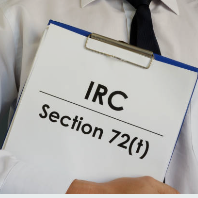The 72(t) rule got its name from a subsection of the Internal Revenue Code. It discusses how people with 401(k)s and other employer-sponsored defined contribution plans can avoid the 10% early withdrawal penalty. They could achieve this by making fairly regular payments over time (such as the Thrift Savings Plan).
Any post-separation withdrawals from the TSP made before the year you reach age 55 will be subject to a 10% penalty. In addition, certain special category personnel (police officers, firefighters, CBPOs, air traffic controllers, Supreme Court and Capitol police officers, nuclear materials couriers, and DSS special agents in the Department of State) must be 50 years old rather than 55.
The penalty also applies to any withdrawals from an IRA before reaching 59½ (not the year you reach 59½, but the actual day you reach 59½), regardless of employment status.
If you take equal periodic payments following Rule 72(t) for five years or until you reach the age of 59½ years, you are exempt from the 10% early withdrawal penalty. So, a normal employee might leave federal service under a VERA at 53 and avoid the early withdrawal penalty on TSP withdrawals by following Rule 72(t) until reaching the age of 59½. The Thrift Savings Plan offers a withdrawal option developed just for this type of person; it’s called installment payments based on the IRS life expectancy table. By selecting that choice, a person effectively elects substantially equal periodic payments and avoids the penalty. It is irrelevant if customers choose monthly, quarterly, or annual installment payments.
Suppose the above employee deviates from this withdrawal option by switching to fixed-dollar-amount installment payments or taking an additional partial withdrawal. In that case, that person will owe early withdrawal penalties retroactively back to the beginning of their withdrawals. You must strictly adhere to its provisions if you intend to employ 72(t) to avoid the early withdrawal penalty.
If you intend to take nearly equal recurring installments from an IRA, consult with the IRA custodian.
Another group of retirees who benefit from a life expectancy-based withdrawal is those 72 years and older who are obligated to take minimum distributions (RMDs) from the TSP and IRAs. Failure to take an RMD results in a penalty of 50% of the missed RMD. For example, if you are obligated to withdraw $12,000 every year but only withdraw $9,000, your penalty will be $1,500 (half of the $3,000 you should have removed but did not). Suppose your IRA custodian arranges for roughly equal recurring installments. In that case, you will withdraw precisely the needed amount and avoid the 50% penalty. The TSP has rules in place to ensure that you are never penalized. For example, suppose you have not taken out the total amount of your RMD after your final payment (December for those taking monthly installment payments). In that case, the TSP will send you an additional payment of the amount required to meet your RMD.
But Hold on, There’s More! One more thing to watch for if you’re receiving TSP payments based on life expectancy tables. The infamous “tax trap” of the TSP. Traditional TSP withdrawals are completely taxable at your usual income tax rate. The TSP states the following regarding deductions from payouts based on life expectancy:
“We are required to withhold federal taxes from any taxable amount as though you are married with three dependents unless you choose a different option.”
This withholding rate is insufficient to meet the taxes due on TSP payments. Therefore, it would be best if you chose a different withholding rate, or you will be surprised at tax time.













